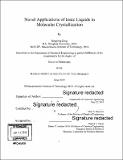| dc.contributor.advisor | Allan S. Myerson. | en_US |
| dc.contributor.author | Zeng, Qingying,Ph.D.Massachusetts Institute of Technology. | en_US |
| dc.contributor.other | Massachusetts Institute of Technology. Department of Chemical Engineering. | en_US |
| dc.date.accessioned | 2019-09-16T21:17:23Z | |
| dc.date.available | 2019-09-16T21:17:23Z | |
| dc.date.copyright | 2019 | en_US |
| dc.date.issued | 2019 | en_US |
| dc.identifier.uri | https://hdl.handle.net/1721.1/122154 | |
| dc.description | Thesis: Ph. D., Massachusetts Institute of Technology, Department of Chemical Engineering, 2019 | en_US |
| dc.description | Cataloged from PDF version of thesis. | en_US |
| dc.description | Includes bibliographical references. | en_US |
| dc.description.abstract | In recent years, pharmaceutical companies have made efforts to study the properties of other potential solvents in active pharmaceutical ingredient (API) synthesis and manufacturing, in order to seek substitutes for toxic and volatile organic solvents, ionic liquids (ILs), which are defined as salts with melting points less than 100° C, have demonstrated great potential in this line due to their desired physicochemical properties: environmentally friendly, low or negligible volatility, high solvency, wide liquidus range, and great tunability. However, significant uncertainties remain regarding the use of ionic liquids as solvents in the pharmaceutical industry, and relevant research studies are lacking. This thesis aims to look at the solvent-solute interaction at a micro level and come up with double salt ionic liquid (DSIL) systems with optimal selection and finely tuned ratio of cations and anions in order to understand, control and improve the crystallization performance. | en_US |
| dc.description.abstract | The thesis first explores the potential of DSILs in the control of crystal growth kinetics. The tailoring help tune both the solubility and the crystal growth kinetics. It is shown that with the increase of basicity in the solvent system, solubility increased linearly while the crystal growth pre-factor dropped. The competition between solvent ions and solute attached onto the surface of crystal seeds explains the decreasing trend of growth rate as the solvent basicity ramps up. This thesis further examines the use of ILs and DSILs in polymorph screening. The mixing and tuning of ILs with various polarity, acidity, hydrogen bond accepting (HBA) and hydrogen bond donating (HBD) capacities helps to control the polymorphic and conformational polymorphic outcomes of the selected systems, and managed to produce forms that were previously discovered by serendipity and never successfully reproduced, even a new IL-API salt. | en_US |
| dc.description.abstract | The combination of spectroscopy evidence and experimental outcome elucidate how the tuning of DSIL system help control the polymorphic outcome of model systems. Last but not least, the thesis proposes and demonstrates the creation of IL-water micellar system for the control of nucleation rate. Crystal habit and preferred orientation studies have proved the similarity of crystals harvested from micellar and non-micellar solutions, thus shown that the templating effect on the surface of micelles is not likely to exist. Herein, it is more likely for micelles to form blockages and slow down the aggregation and nucleation of the model compound. | en_US |
| dc.description.statementofresponsibility | by Qingying Zeng. | en_US |
| dc.format.extent | 147 pages | en_US |
| dc.language.iso | eng | en_US |
| dc.publisher | Massachusetts Institute of Technology | en_US |
| dc.rights | MIT theses are protected by copyright. They may be viewed, downloaded, or printed from this source but further reproduction or distribution in any format is prohibited without written permission. | en_US |
| dc.rights.uri | http://dspace.mit.edu/handle/1721.1/7582 | en_US |
| dc.subject | Chemical Engineering. | en_US |
| dc.title | Novel applications of ionic Liquids in molecular crystallization | en_US |
| dc.type | Thesis | en_US |
| dc.description.degree | Ph. D. | en_US |
| dc.contributor.department | Massachusetts Institute of Technology. Department of Chemical Engineering | en_US |
| dc.identifier.oclc | 1117714959 | en_US |
| dc.description.collection | Ph.D. Massachusetts Institute of Technology, Department of Chemical Engineering | en_US |
| dspace.imported | 2019-09-16T21:17:20Z | en_US |
| mit.thesis.degree | Doctoral | en_US |
| mit.thesis.department | ChemEng | en_US |
